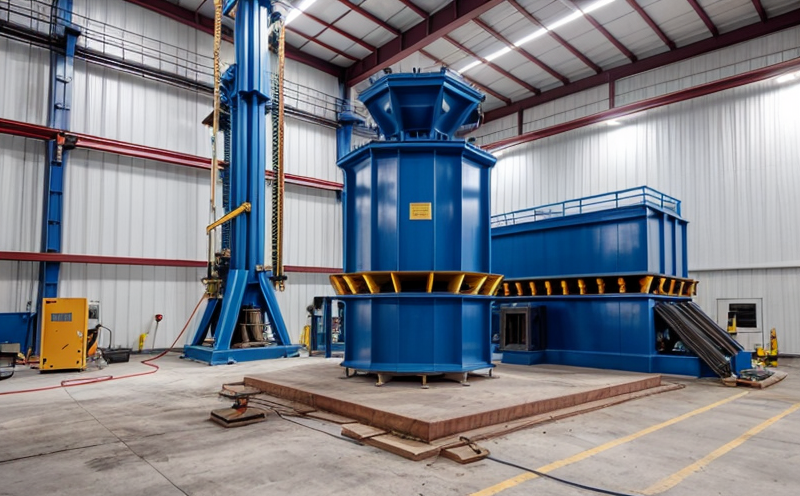ISO 4965 Fatigue Testing Under Dynamic Vibration Loads
The ISO 4965 fatigue testing under dynamic vibration loads is a critical procedure used to assess the structural integrity and durability of components exposed to fluctuating mechanical stresses. This test is particularly relevant in industries such as aerospace, automotive, and manufacturing where materials are subjected to rapid changes in loading conditions, resulting in cyclic stress.
The process involves simulating real-world dynamic loading scenarios on a specimen under controlled laboratory conditions. The objective is to determine the fatigue life of the material or component by measuring how it behaves during repeated cycles of applied loads. This test ensures that products can withstand anticipated operational environments without failure due to fatigue cracks forming over time.
Dynamic load testing helps in understanding the relationship between stress intensity and frequency, providing valuable insights into potential issues before they manifest as failures in actual use situations. By adhering closely to ISO 4965 standards, laboratories ensure consistent and reliable test results that are internationally recognized, enhancing trust among clients and stakeholders.
For instance, aerospace components need to endure extreme conditions during takeoff and landing cycles; thus, fatigue testing plays a vital role in ensuring safety. Similarly, automotive parts experience varying forces due to road surfaces and driving habits, making ISO 4965 compliance essential for product reliability.
The test setup typically includes a vibration testing machine capable of generating controlled frequency ranges mimicking expected operational environments. Specimens are carefully prepared according to industry best practices before being subjected to repeated stress cycles until failure occurs or predetermined limits are reached. Reporting involves detailed documentation including graphical representations of load versus time plots, peak-to-peak values, and any observed anomalies.
Understanding the nuances behind this testing method requires familiarity with both theoretical principles and practical applications. For quality managers and compliance officers, knowing how to interpret these results accurately is crucial for decision-making processes regarding product development and regulatory approvals. R&D engineers benefit from such knowledge when designing prototypes that meet stringent performance criteria early in the design phase.
Moreover, understanding the significance of ISO 4965 fatigue testing under dynamic vibration loads extends beyond technical aspects into broader implications for business operations. Ensuring compliance with international standards not only enhances brand reputation but also reduces risks associated with non-compliant products entering markets.
Scope and Methodology
| Test Parameter | Description | Method |
|---|---|---|
| Vibration Frequency Range | The range of frequencies at which the specimen will be subjected to dynamic loading. | Defined by ISO 4965 and tailored to match specific application requirements. |
| Loading Amplitude | The magnitude of force applied during each cycle, measured in Newtons or pounds-force. | Determined based on expected operational conditions. |
| Number of Cycles | The total number of stress cycles the specimen must endure before being evaluated for fatigue damage. | Set according to predefined criteria that align with product design goals. |
| Data Acquisition System | A system responsible for recording all relevant data points throughout testing. | Incorporates high-precision sensors and software capable of real-time monitoring. |
| Specimen Preparation | The process of preparing the specimen to ensure accurate results during testing. | Includes cleaning, marking, and attaching necessary fixtures for secure attachment to the machine. |
Adhering strictly to these parameters ensures that the test remains consistent with internationally recognized standards. The methodology outlined in ISO 4965 provides a robust framework for conducting fatigue tests under dynamic vibration loads, ensuring accurate and repeatable results.
Benefits
- Enhanced Product Reliability: Identifies potential weaknesses early on, allowing manufacturers to address them before mass production begins.
- Informed Decision Making: Provides data-driven evidence supporting decisions related to material selection and design optimization.
- Risk Mitigation: Reduces the likelihood of unexpected failures in end products, thereby minimizing safety hazards for users.
- Cost Efficiency: Identifies issues early in the development process, preventing costly rework or recalls later on.
- Compliance Assurance: Ensures adherence to relevant international standards like ISO 4965, facilitating smoother regulatory approval processes.
- Competitive Advantage: Demonstrates commitment to quality and innovation, setting the stage for market leadership.
The benefits extend beyond mere compliance; they contribute significantly towards building customer confidence and fostering long-term relationships. By leveraging ISO 4965 fatigue testing under dynamic vibration loads, organizations can achieve higher levels of trustworthiness and reputation within their respective markets.
Why Choose This Test
The choice to conduct ISO 4965 fatigue tests under dynamic vibration loads is driven by several compelling reasons. Firstly, it offers unparalleled insights into the behavior of materials when subjected to cyclic stress conditions, which are common in many engineering applications.
- Realistic Simulation: The test environment closely mimics real-world operational scenarios, providing accurate predictions about product performance.
- Predictive Capabilities: By identifying fatigue cracks early on, manufacturers can implement corrective measures before they become critical defects.
- Cost-Effective: Early detection of weaknesses prevents costly repairs or replacements later in the lifecycle of a product.
- Regulatory Compliance: Meeting international standards enhances confidence among regulators and stakeholders, facilitating smoother market entry for new products.
- R&D Support: Provides valuable data that can inform further research and development efforts aimed at improving existing designs or creating entirely new solutions.
- Customer Satisfaction: Ensures higher quality products reaching the end-user, leading to increased customer satisfaction and loyalty.
In summary, choosing ISO 4965 fatigue testing under dynamic vibration loads is a strategic decision that aligns with broader business objectives centered around innovation, quality assurance, and competitive advantage. It represents an investment in long-term success by ensuring reliability and durability of critical components across various industries.





